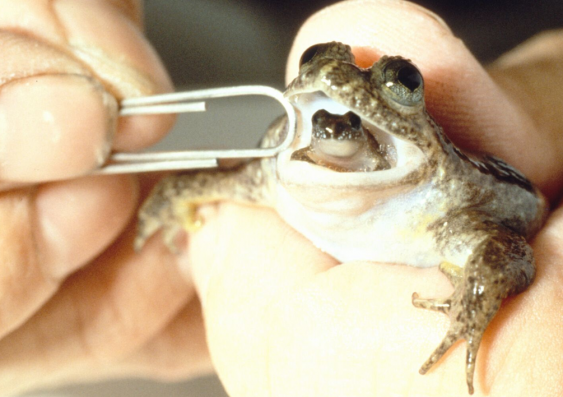Are you a fan of the Jurassic Park films? Though in the movie the dinosaurs obviously went rogue, is there a part of you that secretly wishes we could resurrect extinct animals? Well, you’re in luck (kinda)! Scientists have made what could be the first step to that coming true, though you might be a little disappointed to hear there will be no dinosaurs (sorry!). Read on to find out how.
In a Jurassic Park-like event, Scientists Resurrected a Frog Species
In 1983, the Gastric-Brooding Frog in Queensland, Australia went extinct. Scientists at the University of New South Wales’ Lazarus Project announced in 2013 that they resurrected it. Well, sort of. They reproduced the extinct frog’s genome. (1)
The scientists used tissue from a dead frog that they had kept frozen since the 1970s. They then implanted its genome successfully into an egg from another closely related frog species. While none of the embryos survived past a few days, genetic tests confirm that the dividing cells contained genetic material from the Gastric-Brooder. (2)
A Little Bit About The Gastric-Brooding Frog
This frog is certainly a rare species indeed. In fact, it really seems like it could be some sort of weird prehistoric creature you could find in Jurassic Park. Why? This is because the gastric brooder gives birth through its mouth. This is where it gets its name.
Scientists believe that the frog species went extinct because of humans. They all eventually died of the same disease. It was a fungal disease that humans unfortunately spread.

Read: Deep Sea Ghost Shark Was Finally Caught on Camera – and Yes, these Pictures are Real!
A Brief Existence But A Big Excitement
Some may consider the experiment unsuccessful. After all, the embryos survived only a mere few days. Team leader Professor Mike Archer, however, says quite the contrary. The fact that they were successfully able to implant the genetic material into the eggs of another frog is a massive win. This means that biology works. Now there are just some technology issues that they need to work out. (3)
“We are watching Lazarus arise from the dead, step by exciting step,” says Archer, of the University of New South Wales, in Sydney. “We’ve reactivated dead cells into living ones and revived the extinct frog’s genome in the process. Now we have fresh cryo-preserved cells of the extinct frog to use in future cloning experiments. We’re increasingly confident that the hurdles ahead are technological, not biological,” (4)
Archer says though that it isn’t so much about bringing species back to life in a Jurassic Park kind of way. Rather, his goal is to support biodiversity. This is one way to prevent the extinction of species. Cloning specialist and frog expert Michael Mahoney who worked on the research with Archer calls it de-extinction. He says it’s like an insurance policy against the future extinction of species.
“We need to have some process by which we can prevent extinction,” he said. “The Jurassic Park scenario is the one people think about when you bring back extinct species. I actually don’t focus so much back on the past, as [on] what is possible in the future.”
The Controversy
Of course, something like this doesn’t come without its controversy and criticisms. Some scientists have pointed out that animals are not just their genomes. Just because you are bringing back a clone or the genetic sequence of them, doesn’t mean they are, well, them.
Their reasoning is because of the way animals learn to be what animal they are: through their parents. An elephant’s parents teach it how to use its trunk to pick up food. A pig teaches its young to roll in the mud to stay cool. Lions teach their cubs how to fight and hunt. If an animal has no living parents to teach it how to do what that animal does, is it really that animal? Or, is it just a mere clone?
A Bit About De-Extinction
Yes, de-extinction is about creating populations of healthy species that were previously who can eventually live on their own in the wild. These animals will then breed, grow in numbers, and contribute to biodiversity and the environment. This is only the half of it, however.
The other goal behind de-extinction is to bring animal species back from the brink of extinction. Aka, save them before there is nothing left to be saved. Groups of scientists around the world are currently working on bringing various extinct animals back into existence. So far, they’ve had some success like those with the gastric-brooding frog. For instance, in 2003 European scientists successfully resurrected a specific species of mountain goat. The goat lasted long enough to be born, however, it died only a few minutes later. Still, scientists are creeping ever further towards a successful species resurrection [5].
Read: Extraordinary 1,400-Year-Old Ginkgo Tree Sheds a Stunning Lake of Golden Leaves Every Autumn
How It Works
There are different ways that scientists can achieve resurrection. We have already seen the way in which they nearly revived the gastric brooder. This method involved inoculating a closely related species using the DNA from a deceased but preserved from the extinct species.
Another method is called “back breeding”. Scientists attempting to resurrect the South African Quagga, a Zebra-like animal with a stripe-less behind, used this. It involves breeding existing zebras that look the most like the quagga over many generations. The end result would be an animal that looks just like the original quaggas.
Scientists looking to resurrect the Wooly Mammoth are using stem cell science. This involves editing the mammoth’s genes into the cells of existing elephants. While these animals, regardless of the method used, will be very similar to the extinct species, they won’t be exactly the same. There are a variety of factors that influence what an animal is, including environmental factors. For these reasons, they won’t ever be exactly the same. They, however, will look the same and require the same living spaces (for example, a mammoth will need to live somewhere cold). That, many scientists say, is close enough [5].
What’s The Point?
Many of these lost species were extremely important to their ecosystems and biodiversity. Not just animal biodiversity, but plants, as well. For example, today the far north is mostly tundra. When mammoths roamed there, however, it was much more diverse. This is because mammoths are natural gardeners, so to speak. They knocked down sapling trees, ate grass, and fertilized the ground with their beneficial feces. After they went extinct, biodiversity took a nosedive and we were left with the arctic tundra that we have today.
By resurrecting certain species, we could help improve the health of many suffering ecosystems. Bringing back more animals species and increasing biodiversity also can save a lot of plant and insect life. This, in turn, helps combat global warming and climate change. Naturally, there are human benefits to this, as well.
Real-Life Jurassic Park Not An Option
Unfortunately (or fortunately?), a real-life Jurassic Park is not possible. In order to resurrect a species, scientists need to have a sample of their DNA. This can come from fossils, however, DNA does degrade over time. Dinosaurs went extinct 65 million years ago, so their DNA has long been lost. Even animals lost a few hundred years ago, other than hose frozen in cold places, are lost [5].
Where these species will live is another question that would make resurrecting dinosaurs impossible. If scientists brought back a species that had gone extinct only in the last few decades and whose original habitat hasn’t changed much, this species could go home. For longer-extinct species, this will look different. Perhaps the climate is completely different, or their original home is now filled with invasive species that might pose a problem for the new (old) one.
As already mentioned, we are still a long way off from actually successfully repopulating our planet with extinct species. Still, this is an exciting technology that could potentially benefit the Earth in a massive way. Though we may not get a real-life Jurassic Park, what will get is something much, much better: A healthy, more sustainable planet.
Keep Reading: Boy Accidentally Finds 66-Million-Year-Old Dinosaur Eggs
Sources
- “Resurrected Frog Gives Us Cause To Brood.” NPR. Scott Simon. March 23, 2013.
- “Extinct frog resurrected with ‘de-extinction’ technology.” The Guardian. Australian Associated Press. November 22, 2013.
- “De-extinction research to feature on ABC TV.” Newsroom. Deborah Smith. March 3, 2017.
- “Scientists produce cloned embryos of extinct frog.” Newsroom. March 15, 2013.
- “De-extinction: Can we bring extinct animals back from the dead?” ScienceFocus. July 10th, 2020.

